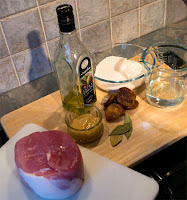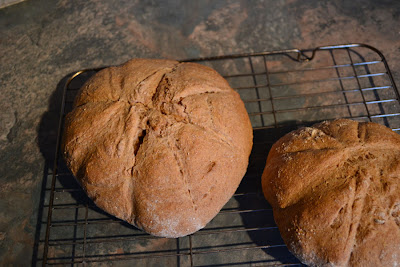We've finally hit a recipe with an ingredient list the length of our collective arms, making this the perfect opportunity to test the theory that the Romans liked to over-season everything. We've also finally hit a recipe with that infamous fish-sauce garum, or more accurately liquamen - there are differences between the two which I'll go into in a later post.
I was browsing through Sally Grainger's Cooking Apicius, as I am wont to do these days, and spotted her Pork and Apricot Minutal. This sounded so delicious that I immediately went in search of the original recipe, which is as follows:
Put some oil, wine, liquamen (fish sauce), diced cooked pork shoulder, and finely chopped onions in a saucepan. When the onions are done, grind some pepper, cumin, mint, and dill, and add to the pan with honey, passum (raisin wine), a splash of vinegar, the juices from the cooked meat, and more liquamen. Remove the seeds from some fruit and add this fruit to the pan. Bring the mixture to the boil, and when cooked, skim the fat from the top, bind everything together, sprinkle with pepper, and serve.- Apicius, 3.6
This differs somewhat from Grainger's take on the minutal. I have decided to stick to the original recipe's ingredients and methods whilst using Grainger's ever-useful measurements. I have also, as you can see from the last post, used tracta from Cooking Apicius as the thickening agent for this dish. Without further ado, let's start this hearty stew.
Pork and Fruit Minutal
Ingredients
- 500g Pork Belly
- 1 Medium Onion
- Several Scallions/Spring Onions
- 300ml Water
- 375ml White Wine
- 2 tbsp Fish Sauce (nam pla)
- 50ml Extra Virgin Olive Oil
- 1 tsp Cumin Seeds
- 1/2 tsp Black Peppercorns
- A Few Sprigs of Fresh Mint
- A Few Sprigs of Fresh Dill
- 1 tbsp Set Honey
- 2 tbsp Red Wine Vinegar
- 1.5 tbsp Raisin Wine
- A Handful of Dried Figs and Apricots.
- 3 Tracta Discs

Method
- Preheat the oven to 180°C.
- Rub the pork belly with olive oil (not from the 50ml of olive oil) and salt, and cook in the oven for approximately half an hour or until done. When finished, leave to cool.
- Add the water, wine, fish sauce, and olive oil to a saucepan, then bring to the boil. I advise giving it a taste, just because it's so deliciously unusual. When it is boiling, add the onions and the pork, and reduce to a simmer.
- Whilst the onions are cooking, toast and grind the cumin seed and the black peppercorns. You know that they're toasting once the cumin starts giving off its distinctive smell. Don't overdo it! Chop the mint and the dill up together also.
- Add the above to the pan alongside the honey, vinegar, raisin wine, and a splash of fish sauce. Give it a stir, bring to the boil briefly, and let it simmer once more.
- Add in the roughly chopped dried apricots and figs.
- Take three of the tracta sheets you fought so hard to make, and watch that hard work turn to nothing as you break the tracta up into fine pieces.
- Add the tracta to the pan whilst stirring. Stir for maybe 5 minutes and watch the minutal thicken. Taste for flavour, season if necessary, and serve with a loaf of freshly baked bread.
Notes
- My liquamen was simply a shop bought nam pla or fish sauce. You'll find it alongside the Asian food. If yours is too dark or too salty then you can adjust the salt levels by mixing it with white grape juice reduced to half of its original volume.
- The passum was a nightmare to find. Grainger likens it to a modern raisin wine, but says that a dessert wine such as a Muscat, which I have used, will work too.
- Tracta are a nightmare to make - if you can't be bothered, add some cornflour instead.
Results
There are not enough adjectives in the English language to describe the beauty of this minutal. The acid from the vinegar and the sweetness from the different wines made it almost tingle in the mouth. The delicate flavours of the dill were surprisingly distinctive, and the mint provided a subtle background to the meaty, savoury aspects of the dish. Because the figs and apricots were only briefly stewed they retained a lot of their fruity flavour, and it was nice to alternate between bites of pork and bites of fruit. The texture was, thanks to the onions and tracta, quite creamy, which meant that it clung well to the bread I ate the dish with.
To those who say that the Romans overseasoned everything I say try this dish - I have never before seen ingredients compliment each other so well as they do in this recipe. The flavours are at once homely and exotic, leading to a profoundly satisfying meal which I will serve for years to come.
























